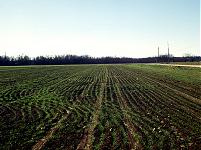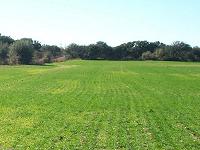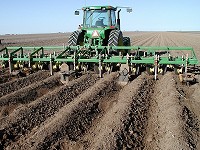

| January 2, 2008 |
 |
|---|
 I still plan to establish a Wild Oat Control Test if the opportunity presents itself. Trying to spray herbicides at this time of the year is always a challenge. I try to wait for a window of opportunity to make the applications. The window I'm looking for has to meet two criteria; they are: 1) prior to the application–air temperature remains above forty degrees for 48 hours, and 2) following the application the air temperature remain above forty degrees for 48 hours. Sounds simple enough but you don't get many opportunities to spray in January.
I still plan to establish a Wild Oat Control Test if the opportunity presents itself. Trying to spray herbicides at this time of the year is always a challenge. I try to wait for a window of opportunity to make the applications. The window I'm looking for has to meet two criteria; they are: 1) prior to the application–air temperature remains above forty degrees for 48 hours, and 2) following the application the air temperature remain above forty degrees for 48 hours. Sounds simple enough but you don't get many opportunities to spray in January.
Over 100,000 acres of wheat was planted in December and the temperatures have remained low through most of the month. This will have a negative impact on the developing wheat plant. These plants will have a small root system and will require timely rain in the Spring in order to develop a grain crop with desirable test weight. Freeze damage can occur in young plants (two to three leaf stage) when air temperatures drops to the 10 to 15 degree range, especially if the soil is dry. If the top 1 to 2 inches of soil is wet, it will serve as insulation to the young wheat plants.
 I know that some producers are asking about fertilizing wheat. Warm temperatures are needed to convert the fertilizer into a form used by the growing plant and it has to be in soil water in order to be absorbed. Half of the nitrogen in ammonium nitrate is in the form used by the plant and no conversion is necessary. It still needs to get into the soil water where the roots are actively absorbing moisture and nutrients. The availability of ammonium nitrate is very limited. The point to this is: 1) dry fertilizer is applied to a dry soil surface and needs to be moved into the soil by a rain; 2) other types of fertilizer are available but they won't be converted into a useful form for the plant until temperatures warm up; 3) plants may stress and tillers may die before nutrient deficiencies can be corrected.
I know that some producers are asking about fertilizing wheat. Warm temperatures are needed to convert the fertilizer into a form used by the growing plant and it has to be in soil water in order to be absorbed. Half of the nitrogen in ammonium nitrate is in the form used by the plant and no conversion is necessary. It still needs to get into the soil water where the roots are actively absorbing moisture and nutrients. The availability of ammonium nitrate is very limited. The point to this is: 1) dry fertilizer is applied to a dry soil surface and needs to be moved into the soil by a rain; 2) other types of fertilizer are available but they won't be converted into a useful form for the plant until temperatures warm up; 3) plants may stress and tillers may die before nutrient deficiencies can be corrected.
Since we ginned cotton late it will be approximately mid-January before we receive the information on lint quality. I will get the information to you as soon as possible. It will be sent to you in an electronic format by e-mail. It will be formatted to be retrieved directly into WordPerfect. NOTE: When you finish your cotton result demonstration reports, I would appreciate it if you would send me a copy by e-mail. Thanks.
Soil sampling to two feet will be important in 2008. Samples should be taken at 0 to 6, 6 to 12, 12 to 18 and 18 to 24. This will give you clear picture to the available nutrients. With the price of fertilizer being higher than last year, producers will only make applications if necessary.
 Producers need to go ahead and prepare the seedbeds for next years crop. Installing furrow dikes in all rows except where the tractor will be traveling will give them the best chance of keeping every drop of rain received in place instead of heading to the low spots.
Producers need to go ahead and prepare the seedbeds for next years crop. Installing furrow dikes in all rows except where the tractor will be traveling will give them the best chance of keeping every drop of rain received in place instead of heading to the low spots.
When rain does occur be diligent about controlling the weeds. Loss of moisture and nutrients by weeds should not be tolerated. For the best control you should be using flat fan nozzles but remember your drift potential is much higher; so be sure you own everything around you if you use this kind of spray tip.
The Beltwide Cotton Conference will be held in Nashville, Tennessee, January 8 - 11, 2008. This is an excellent meeting for increasing your knowledge about cotton production. For more information go to the following URL http://beltwide.cotton.org/.
There will be five CEUs offered at the forage production meeting held in Cross Plains on February 5. For more information on the meeting call Robert Pritz at (325) 854-5835.
CEUs will be available at the West Texas Farm, Ranch and Wildlife Show held February 19 & 20, 2008 at Abilene, Texas. A pesticide applicator can earn CEUs throughout the day. Just have them call the Taylor County Extension Office at (325) 672-6048 for more information.
 January 7 - 10, Brazos County, Ag Program Conference
January 7 - 10, Brazos County, Ag Program Conference
 January 15, Pecos County, Cotton Update
January 15, Pecos County, Cotton Update
 January 15, Glasscock County, Result Demonstration Review
January 15, Glasscock County, Result Demonstration Review
 January 22, Martin County, Permian Basin Cotton Conference
January 22, Martin County, Permian Basin Cotton Conference
 January 29 - 31, Travis County, TX-OK Cotton Physiology and Harvest Aid Study Group
January 29 - 31, Travis County, TX-OK Cotton Physiology and Harvest Aid Study Group
 February 5, Callahan County, Forage Seminar
February 5, Callahan County, Forage Seminar
 February 6-8, Bexar County, Bayer Crop Science Meeting
February 6-8, Bexar County, Bayer Crop Science Meeting
 February 12 & 13, El Paso County, Cotton Production Meeting
February 12 & 13, El Paso County, Cotton Production Meeting
 February 19 & 20, Taylor County, West Texas Farm and Ranch Show
February 19 & 20, Taylor County, West Texas Farm and Ranch Show
 February 21, San Saba County, Pasture Management Meeting
February 21, San Saba County, Pasture Management Meeting
 February 21, Burnet County, Plant Growth and Development Presentation
February 21, Burnet County, Plant Growth and Development Presentation
Sincerely,
|